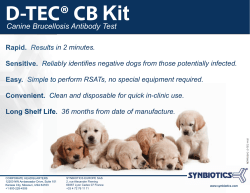
Interceptive Treatment Of Palatally Displaced Canines
Interceptive Treatment Of Palatally Displaced Canines Studies of treatment effect and patients’ perception and methodological evaluation of 3D measurements of CBCT Akademisk avhandling som för avläggande av odontologie doktorsexamen vid Sahlgrenska akademin vid Göteborgs universitet kommer att offentligen att försvaras i hörsal Arvid Carlsson, Medicinaregatan 3, Göteborg, tisdagen den 11 november 2014 kl. 13.00 av Julia Naoumova Leg.tandläkare Fakultetsopponent: Dr. Sheldon Peck Department of Orthodontics, University of North Carolina, Chapel Hill, USA Avhandlingen är av sammanläggningstyp och är baserad på följande delarbeten: I Naoumova, J Palm R, Kjellberg H. Cone-beam computed tomography for assessment of palatal displaced canine position - A methodological study. The Angle Orthodontist 2014 May: 84(3): 459-466 II Naoumova J, Kjellberg H, Kurol J, Mohlin B. Pain, discomfort, and use of analgesics following the extraction of primary canines in children with palatally displaced canines. International Journal of Paediatric Dentistry 2012 Jan: 22(1): 17-26 III Naoumova J, Kurol J, Kjellberg H. Extraction of the deciduous canine as an interceptive treatment in children with palatal displaced canines - Part I: Shall we extract the deciduous canine or not? The European Journal of Orthodontics 2014;doi: 10.1093/ejo/cju040 IV Naoumova J, Kurol J, Kjellberg H. Extraction of the deciduous canine as an interceptive treatment in children with palatal displaced canines - Part II: Possible predictors and cut-off points for a spontaneous eruption. Accepted for publication to The European Journal of Orthodontics ABSTRACT Interceptive Treatment Of Palatally Displaced Canines Studies of treatment effect and patients’ perception and methodological evaluation of 3D measurements of CBCT Julia Naoumova Department of Orthodontics, Institute of Odontology, the Sahlgrenska Academy at University of Gothenburg, Box 450, SE 405 30 Göteborg, Sweden Background: In 2 % of the Swedish population the canine fails to erupt and in 85 % of the cases the canine is palatally displaced. The most common interceptive treatment of palatally displaced canines (PDCs) is extraction of the deciduous canine at the age of 10-13 years and follow-up of the canine for 12 months to monitor whether its eruption path will normalize. In case the canine does not erupt spontaneously, a surgical exposure and orthodontic treatment is commonly considered. However, an early and easy interceptive treatment is preferable both from a health economic perspective as well as to reduce the risk of root resorption of the adjacent teeth and to avoid later comprehensive treatment/s. Objective: The aims of this thesis were: to develop a reliable and valid method to measure the position of PDCs on 3D images (Cone Beam Computed Tomography, CBCT) (paper I). To evaluate children’s subjective experience before, during and after extraction of the deciduous canine (paper II). To compare whether extraction of the deciduous canine more often results in spontaneous eruption of the permanent canine compared to non extraction (paper III) and to find out which clinical cases benefit from interceptive extraction (paper IV). Materials and Methods: In total 89 PDCs in 67 children (10-13 years of age) were randomly assigned to either have their deciduous canine extracted (extraction group, EG) or not extracted (control group, CG). Clinical and radiographic examinations were carried out at baseline (T0), after 6 (T1) and 12 months (T2) in both groups. 3D images of 20 patients out of 67 were randomly chosen and measured by two dentists at different occasions. The validity of the method to measure the displaced canines was assessed by comparing measurements on the 3D images with measurements on a dry skull. Children who had extraction of the deciduous canine were asked to answer a questionnaire before, the same day as and one week after the extraction. Results: • The radiographic method to measure and assess the position of the PDCs on 3D images was reliable and had a high validity (paper I). • The reported pain and discomfort were in overall low. The injection was experienced as more painful compared to the extraction, and analgesics were taken the first evening by 42 % of the children (paper II). • Extraction of the deciduous canine resulted in eruption of the PDCs in 69 % of the cases compared to 39% in the CG. Significantly more positional changes and a shorter mean eruption time were seen in the EG (paper III). • PDCs with a mesioangular angle of 103°, distance of the canine cusp tip-dental arch plane of 2.5 mm and distance of the canine cusp tip-midline of 11 mm in patients < 11 years will likely erupt without interceptive extraction. However, PDCs with a less favourable position, i.e. a mesioangular angle of 116 degrees, canine cusp tip-dental arch plane of 5mm and canine cusp tip-midline of 6 mm, in patients > 11-12 years old, will not erupt spontaneously in spite of interceptive extraction of the deciduous canine (paper IV). Conclusions: The radiographic method to measure and assess the position of the PDCs was reliable and valid and can be used in future studies. Adequate analgesics and dose should be given to children before and after extracting the deciduous canine. Interceptive extraction of the deciduous canine at 10-13 years of age was effective and will result in significantly more spontaneous eruptions of the permanent canine compared to a control group. The cutoff points may be a helpful tool for the clinician to chose whether the patient benefit from interceptive extraction of the deciduous canine or whether immediate surgical exposure should be performed. Keywords: palatally displaced canines, orthodontics, interceptive treatment, extraction of deciduous canine, cone beam computed tomography, patient perception, pain, questionnaire Swedish Dental Journal Supplement 234, 2014 ISSN 0348-6672, ISBN 978-91-628-9109-1, GUPEA http://hdl.handle.net/2077/36747
© Copyright 2025












